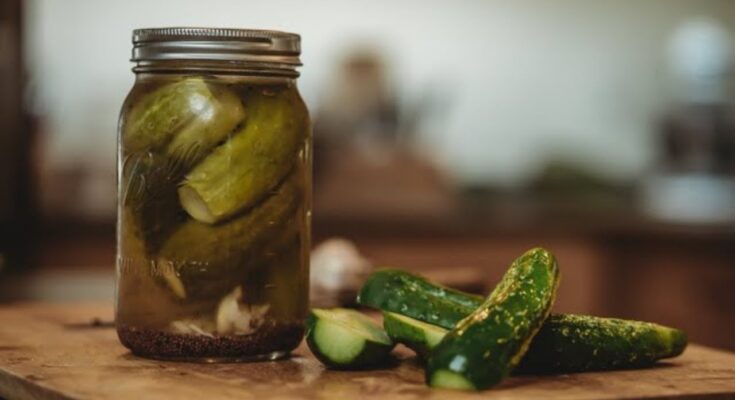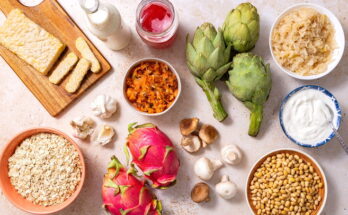Dill Pickle Recipe: There’s nothing quite like the tangy crunch of a homemade dill pickle! Whether you’re topping a burger, snacking straight from the jar, or adding zest to your favorite sandwich, dill pickles are a versatile favorite in kitchens worldwide.
Making your own pickles at home is surprisingly easy, fun, and incredibly rewarding. With just a few ingredients and tools, you can create flavorful pickles that beat store-bought options any day.
Ingredients for Dill Pickles
To make the perfect dill pickles, you’ll need a mix of essential ingredients and optional flavor enhancers:
Essential Ingredients:
- Fresh cucumbers (pickling cucumbers or Kirby cucumbers work best)
- Fresh dill sprigs
- Garlic cloves
- White vinegar or apple cider vinegar
- Water
- Kosher salt
- Whole black peppercorns
Optional Flavor Enhancers:
- Mustard seeds
- Red pepper flakes (for a spicy kick)
- Bay leaves
- Fresh or dried chili peppers
- Sugar (for a slight sweetness)
Having these ingredients ready ensures a smooth pickling process with a rich, balanced flavor profile.
Tools You’ll Need
Before diving into the recipe, gather the tools you’ll need for safe and efficient pickle-making:
- Mason jars with lids
- Large pot for boiling water
- Tongs or jar lifter
- Measuring cups and spoons
- Cutting board and knife
- Funnel (optional, but helpful)
- Clean kitchen towels
Preparation Tips:
- Inspect jars for cracks or chips before starting.
- Keep all tools clean and sanitized to avoid contamination.
Choosing the Right Cucumbers
Not all cucumbers are created equal when it comes to pickling. For the best results:
Types of Cucumbers:
- Use small, firm cucumbers such as Kirby or Persian cucumbers.
- Avoid wax-coated cucumbers as they don’t absorb the brine well.
Preparation Steps:
- Wash cucumbers thoroughly under running water.
- Trim the ends of the cucumbers, especially the blossom end, as it contains enzymes that can cause pickles to soften.
- If desired, slice cucumbers into spears or rounds for different pickle shapes.
Sterilizing Your Jars
Sterilizing jars is a critical step to ensure your pickles are safe to eat and free from harmful bacteria.
Step-by-Step Process:
- Wash jars and lids with hot, soapy water and rinse thoroughly.
- Place jars in a large pot of boiling water, ensuring they are fully submerged.
- Boil jars for 10 minutes to sterilize them.
- Remove jars with tongs and place them on a clean kitchen towel to dry.
Pro Tip: Keep jars warm until you’re ready to fill them to prevent cracking when adding hot brine.
Creating the Pickling Brine
The brine is the heart of any good pickle recipe. Here’s how to make it:
Ingredients:
- 1 cup vinegar
- 1 cup water
- 1 tablespoon kosher salt
Instructions:
- Combine vinegar, water, and salt in a saucepan.
- Heat the mixture over medium heat, stirring until the salt dissolves.
- Let the brine cool slightly before pouring it over the cucumbers.
The key to perfect brine is balance—adjust the vinegar-to-water ratio for a tangier or milder pickle.
Preparing the Dill and Spices
Dill is the star ingredient that gives dill pickles their distinctive flavor. Alongside dill, a well-chosen blend of spices can elevate the taste of your pickles.
Fresh Dill vs. Dried Dill:
- Use fresh dill sprigs for a bold, aromatic flavor. You can also use dried dill seeds in a pinch, but fresh is always preferable for a more robust taste.
Other Essential Spices:
- Garlic cloves: Crushed or halved for a subtle punch.
- Black peppercorns: Add a mild, peppery kick.
- Mustard seeds: Provide a tangy depth of flavor.
Layering the Flavors:
- Add a few sprigs of dill and garlic cloves to the bottom of each jar.
- Sprinkle in mustard seeds, peppercorns, and any optional spices like red pepper flakes or bay leaves.
- Pack the cucumbers snugly over the spices for even flavor distribution.
Filling the Jars
The way you pack the jars is essential to achieving well-flavored and visually appealing pickles.
Packing Cucumbers:
- Arrange cucumbers tightly in the jar, leaving about 1/2 inch of headspace at the top.
- Alternate whole cucumbers with slices or spears for variety if desired.
Adding Brine:
- Pour the warm brine over the cucumbers, ensuring they are fully submerged.
- Use a clean spoon to press down cucumbers and release any trapped air bubbles.
- Top off with additional brine if necessary, maintaining the 1/2-inch headspace.
Pro Tip: Place a small dill sprig on top before sealing for an extra touch of flavor and presentation.
Sealing the Jars
Properly sealing your jars is crucial for preserving freshness and extending shelf life.
Steps for Sealing:
- Wipe the rim of each jar with a clean, damp cloth to remove any residue.
- Place the lid on top and screw the band down until it’s fingertip-tight. Avoid over-tightening, as this can interfere with the canning process.
- Double-check that jars are packed securely before moving to the next step.
Water Bath Canning Process
Water bath canning ensures your pickles stay safe for long-term storage while enhancing their flavor.
Why It’s Important: This process heats the jars to eliminate bacteria, creating a vacuum seal that prevents spoilage.
Step-by-Step Instructions:
- Fill a large pot or canning kettle with enough water to fully submerge the jars.
- Bring the water to a rolling boil.
- Using tongs or a jar lifter, carefully lower the jars into the boiling water.
- Process jars for 10-15 minutes, adjusting for altitude if necessary (consult a canning chart for specifics).
- Once processed, remove jars and place them on a towel-lined surface to cool.
Pro Tip: Avoid sudden temperature changes, as they can cause jars to crack.
Cooling and Storing Pickles
Once the jars have been processed, it’s essential to handle them properly as they cool.
Cooling Process:
- Allow jars to sit undisturbed for 12-24 hours. You may hear a “ping” sound as the jars seal—this is a good sign!
- Check the lids by pressing the center. If the lid doesn’t pop back, the jar is sealed properly.
Storage Tips:
- Store jars in a cool, dark place, such as a pantry or cupboard.
- Label each jar with the date of preparation for easy tracking.
How Long to Wait Before Eating
Patience is key when it comes to pickles! While it’s tempting to dig in immediately, allowing your pickles to ferment for a few weeks will maximize their flavor.
Fermentation Timeline:
- For refrigerator pickles: Wait 24-48 hours for a quick, mild flavor.
- For canned pickles: Let them sit for 2-4 weeks to develop a deeper, tangier taste.
Testing Readiness: Open a jar after the recommended time, taste a pickle, and adjust future recipes based on your flavor preferences.
Common Mistakes to Avoid
Even seasoned picklers can run into a few snags. Here’s how to avoid common issues:
Mushy Pickles:
- Use fresh cucumbers and trim the blossom ends.
- Avoid overcooking during the canning process.
Cloudy Brine:
- Use pickling salt instead of table salt, as table salt contains additives that can cloud the brine.
Unsealed Jars:
- Double-check for debris on jar rims before sealing.
- Ensure lids are properly sterilized and fitted.
Creative Variations of Dill Pickles
Why stick to basic dill pickles when you can experiment with exciting variations?
Spicy Dill Pickles:
- Add red pepper flakes, sliced jalapeños, or dried chili peppers for a fiery kick.
Garlic Dill Pickles:
- Double the garlic for a bold, garlicky punch.
Sweet Dill Pickles:
- Mix in a tablespoon of sugar or honey for a tangy-sweet balance.
Health Benefits of Dill Pickles
Dill pickles are more than just a tasty treat—they offer several health benefits:
- Low-Calorie Snack: Perfect for guilt-free munching.
- Rich in Probiotics: Naturally fermented pickles support gut health.
- Source of Antioxidants: Dill and cucumbers provide vitamins A and C.
Serving Ideas and Pairings
Dill pickles are versatile and complement many dishes:
- Add to burgers, sandwiches, or wraps for a burst of flavor.
- Dice and mix into potato or pasta salads.
- Serve alongside cheese boards or charcuterie platters.
FAQs About Dill Pickle Recipe
1. What ingredients are needed for a dill pickle recipe?
To make dill pickles, you typically need fresh cucumbers, dill, garlic, vinegar, water, salt, sugar, and optional spices like peppercorns or red pepper flakes. These ingredients create a tangy and flavorful brine that pickles the cucumbers.
2. How long does it take to make dill pickles?
Preparing dill pickles usually takes about 15-20 minutes. However, they need to sit in the brine for at least 24-48 hours in the refrigerator for optimal flavor. For a stronger taste, let them pickle for up to a week.
3. Can I use apple cider vinegar instead of white vinegar?
Yes, apple cider vinegar is a great substitute for white vinegar in dill pickle recipes. It adds a slightly sweeter and fruitier flavor to the pickles.
4. How do I store homemade dill pickles?
Store homemade dill pickles in a sterilized, airtight jar in the refrigerator. They can last up to 2-3 months when properly sealed and kept cold.
5. Are dill pickles healthy?
Dill pickles are low in calories and can be a healthy snack. They are also a good source of probiotics if made using a fermentation process. However, they can be high in sodium, so moderation is key.
6. Can I add other vegetables to the recipe?
Absolutely! You can pickle carrots, cauliflower, green beans, or peppers alongside cucumbers for a delicious variety. Just ensure all vegetables are evenly sliced and fully submerged in the brine.
7. Why are my pickles soft instead of crunchy?
Soft pickles may result from using overripe cucumbers or failing to keep them submerged in the brine. To ensure crunchiness, start with fresh, firm cucumbers and consider adding grape leaves or a pinch of calcium chloride to the brine.
Conclusion
Making dill pickles at home is a rewarding experience that combines creativity and practicality. With just a few ingredients and some patience, you can create pickles that perfectly suit your taste buds. Why settle for store-bought when homemade tastes so much better?



